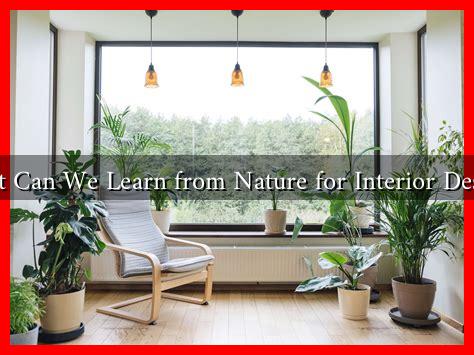-
Table of Contents
- What Can We Learn from Nature for Interior Design?
- The Biophilic Design Concept
- Key Elements of Biophilic Design
- Color Palettes Inspired by Nature
- Examples of Nature-Inspired Color Schemes
- Patterns and Textures from the Natural World
- Incorporating Natural Patterns
- Case Studies: Successful Nature-Inspired Interiors
- Conclusion: Embracing Nature in Interior Design
What Can We Learn from Nature for Interior Design?
Nature has always been a source of inspiration for various fields, including art, architecture, and, notably, interior design. The principles and aesthetics found in the natural world can significantly enhance our living spaces, making them more harmonious, functional, and visually appealing. This article explores the lessons we can learn from nature and how they can be applied to interior design.
The Biophilic Design Concept
Biophilic design is a concept that emphasizes the human connection to nature. It suggests that incorporating natural elements into our interiors can improve well-being, productivity, and creativity. According to a study published in the *Journal of Environmental Psychology*, environments that include natural elements can reduce stress and enhance mood.
Key Elements of Biophilic Design
- Natural Light: Maximizing natural light can create a sense of openness and connection to the outdoors. Large windows, skylights, and open floor plans can help achieve this.
- Natural Materials: Using materials like wood, stone, and bamboo can bring the essence of nature indoors. These materials not only look beautiful but also have a tactile quality that enhances the sensory experience.
- Indoor Plants: Incorporating greenery into interior spaces can improve air quality and create a calming atmosphere. Studies show that having plants indoors can increase productivity by up to 15%.
- Water Features: The sound of water can be soothing and is often associated with tranquility. Indoor fountains or aquariums can serve as focal points while promoting relaxation.
Color Palettes Inspired by Nature
Nature offers a rich palette of colors that can be effectively used in interior design. From the calming blues of the ocean to the earthy tones of forests, these colors can evoke specific emotions and create desired atmospheres.
Examples of Nature-Inspired Color Schemes
- Ocean Blues: Shades of blue can create a serene and peaceful environment, perfect for bedrooms and bathrooms.
- Forest Greens: Green hues can promote relaxation and rejuvenation, making them ideal for living rooms and workspaces.
- Earthy Neutrals: Browns, beiges, and soft whites can create a warm and inviting atmosphere, suitable for any room in the house.
According to the *Pantone Color Institute*, colors inspired by nature can influence mood and behavior, making them a powerful tool in interior design.
Patterns and Textures from the Natural World
Nature is full of intricate patterns and textures that can be translated into interior design. From the delicate veins of leaves to the rugged surfaces of rocks, these elements can add depth and interest to a space.
Incorporating Natural Patterns
- Floral Patterns: Floral wallpapers or fabrics can bring a touch of nature indoors, adding vibrancy and life to a room.
- Geometric Shapes: Inspired by natural formations, geometric patterns can create a modern aesthetic while still paying homage to the organic world.
- Textured Surfaces: Using textured materials like reclaimed wood or stone can add a tactile quality that enhances the sensory experience of a space.
Case Studies: Successful Nature-Inspired Interiors
Several designers and architects have successfully integrated nature into their projects, showcasing the benefits of this approach.
- The Eden Project, UK: This iconic structure features biomes that house diverse plant species, demonstrating how architecture can harmonize with nature.
- Green Roofs: Many urban buildings now incorporate green roofs, which not only provide insulation but also create green spaces in densely populated areas.
- Forest House, Japan: This residence is designed to blend seamlessly with its forest surroundings, using large windows and natural materials to create a cohesive environment.
Conclusion: Embracing Nature in Interior Design
Incorporating elements from nature into interior design can lead to spaces that are not only aesthetically pleasing but also promote well-being and sustainability. By embracing biophilic design principles, utilizing nature-inspired color palettes, and integrating natural patterns and textures, we can create environments that resonate with our innate connection to the natural world.
As we continue to navigate urbanization and technological advancements, looking to nature for inspiration in interior design can help us create spaces that nurture our physical and mental health. By doing so, we not only enhance our living environments but also foster a deeper appreciation for the beauty and complexity of the natural world.
For more insights on biophilic design and its benefits, you can visit Biophilic Design Network.

